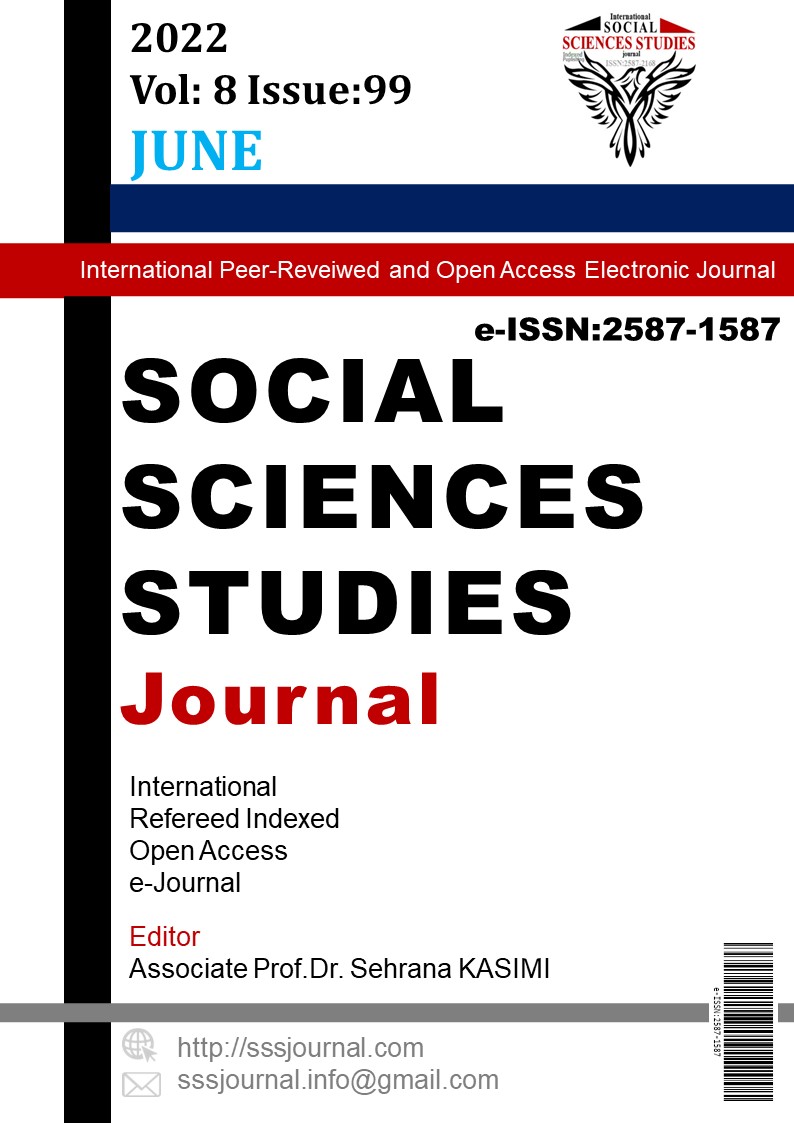Author :
Abstract
Amaç: Bu çalışmanın amacı, farklı spor dallarında faaliyet gösteren amatör sporcuların bilgi okur yazarlık ve mutluluk düzeylerinin incelenmesidir. Gereç ve Yöntem: Araştırmaya Ordu ilinde faaliyet gösteren ve gönüllü olan 230 amatör sporcu katılmıştır. Verilerin toplanmasında, sporcuların özelliklerini belirlemek amacıyla oluşturulan anket, Doğan ve Akıncı Çötok (2011) tarafından geliştirilen Oxford Mutluluk Ölçeği Kısa Formu (OMO) ile Adıgüzel (2011) tarafından geliştirilen Bilgi Okuryazarlığı Ölçeği (BOYO) kullanılmıştır. Bulgular: Katılımcıların cinsiyete göre mutluluk düzeyleri incelendiğinde, erkeklerin mutluluk düzeylerinin kadınlara göre istatistiksel olarak anlamlı olduğu (p>0.05), ancak cinsiyete göre bilgi okur yazarlık düzeylerinde arasında kadınların erkeklere göre istatistiksel olarak anlamlı olduğu (p>0.05) görüldü. Bireysel spor yapanlarla takım sporları yapan amatör sporcular arasında hem bilgi okur yazarlık düzeyleri hem de mutluluk düzeyleri arasında herhangi istatistiksel bir fark çıkmamıştır. Araştırmada 25-34 yaş arası spor yapan amatör sporcuların mutluluk düzeyleri diğer yaş gruplarına göre yüksek olduğu ayrıca 35-44 yaş arası spor yapan amatör sporcuların bilgi okur yazarlık düzeyleri diğer yaş gruplarına göre yüksek olduğu görüldü. Diğer yandan lisans mezunu olan amatör sporcuların mutluluk düzeyleri ön lisans mezununa göre daha yüksek olduğu; lise mezunu amatör sporcuların bilgi okur yazarlık düzeylerinin diğer mezunlara göre daha düşük olduğu görüldü. Ayrıca 2001-3000 TL arası gelir düzeyi olan amatör sporcuların mutluluk düzeyleri 1001-2000 TL arası ve 3001 ve üzerinden daha ayrıca 1001-2000 TL arası gelir düzeyi olan amatör sporcuların bilgi okur yazarlık düzeyleri 2001-3000 TL arası ve 3001 ve üzeri gelir düzeyi olan gruplardan daha yüksek olduğu ortaya çıkmıştır.
Keywords
Abstract
Purpose: The aim of this study is to examine the information literacy and happiness levels of amateur athletes operating in different sports branches. Materials and Methods: 230 volunteer amateur athletes operating in the province of Ordu participated in the research. In collecting the data, the questionnaire created to determine the characteristics of the athletes, the Oxford Happiness Scale Short Form (OMO) developed by Doğan and Akıncı Çötok (2011), and the Information Literacy Scale (BOYO) developed by Adıgüzel (2011). Results: When the happiness levels of the participants were analyzed according to gender, it was seen that the happiness levels of men were statistically significant compared to women (p>0.05), but the level of information literacy by gender was statistically significant compared to men (p>0.05). There was no statistical difference between both the information literacy levels and the happiness levels between the individual sports and the amateur athletes who do team sports. In the study, it was seen that the happiness levels of amateur athletes between the ages of 25-34 were higher than other age groups, and the information literacy levels of amateur athletes between the ages of 35-44 were higher than other age groups. On the other hand, the happiness levels of amateur athletes with a bachelor's degree are higher than those with an associate degree; It was seen that the information literacy levels of high school graduate amateur athletes were lower than other graduates. In addition, the happiness levels of amateur athletes with income levels between 2001-3000 TL and those with income levels between 2001-3000 TL and 3001 and above, and amateur athletes with income levels between 2001-3000 TL and 3001 and above. found to be higher than the other groups.
Keywords
- Adıgüzel, A. (2011). Bilgisayar Okuryazarlığı Ölçeğinin Geliştirilmesi. Dicle Üniversitesi Ziya Gökalp Eğitim Fakültesi Dergisi, 15-28 .
- ALA. (2008). Presidential Committee on Information Literacy. Alabama: American Library Association.
- Baumgardner, S. R., & Crothers, M. K. (2010). Positive psychology. New Jersey: Pearson Education International.
- Clark, A., & Mach, N. (2016). Exercise-induced stress behavior, gut-microbiota-brain axis and diet: A systematic review for athletes. J. Int. Soc. Sports Nutr., 13-20.
- Çiçek, G. (2018). Spor Yapan ve Yapmayan Yetişkin Bireylerin İletişim Becerileri Düzeylerinin Karşılaştırılması. Electronic Turkish Studies, 3-19.
- Doğan, T., & Akıncı Çötok, N. (2011). Oxford Mutluluk Ölçeği Kısa Formunun Türkçe Uyarlaması: Geçerlik ve Güvenirlik Çalışması. Türk Psikolojik Danışma ve Rehberlik Dergisi, 165-172.
- Engström, L.-M. B. (2004). arns och ungdomars idrottsvanor i förändring. Svensk Idrottsforskning. Organ för Centrum för Idrottsforskning, 10–15.
- Fredrickson, B. L. (2000). Cultivating positive emotions to optimize health and well-being. Prevention & Treatment, 218–226.
- Gorman, J. O., & Trott, B. (2009). What Will Become of Reference in Academic and Public Libraries? Journal of Library Administration, 327–339.
- Gökdemir-Dumludağ, Ö. (2011). Mutluluk ve iktisadi parametreler üzerine bir inceleme (Doktora Tezi). İstanbul: İstanbul Üniversitesi Sosyal Bilimler Enstitüsü.
- Gülcan, A., & Nedim-Bal, P. (2014). Genç yetişkinlerde iyimserliğin mutluluk ve yaşam doyumu üzerindeki etkisinin incelenmesi. Asya Öğretim Dergisi, 41-52.
- Hume, D. (2001). Emotions and moods. Organizational Behavior, 258–297.
- Khan, K., Thompson, A., Blair, S., Sallis, J., Powell, K., Bull, F., & Bauman, A. (2012). Sport and exercise as contributors to the health of nations. Lancet, 59–64.
- Kjonniksen, L., Anderssen, N., & Wold, B. (2009). Organized youth sport as a predictor of physical activity in adulthood. Scand. J. Med. Sci. Sports, 646–654.
- Kurniati, N., & Atikasari, F. (2018). The Happiness Level of Students from Borneo. Advances in Social Science, Education and Humanities Research (ASSEHR), 304-307.
- Lloyd, A. (2006). Information Literacy Landscapes: An Emerging Picture. Journal of Documentation, 570–583.
- Mutlu, O., Şentürk, H., & Zorba, E. (2014). Üniversite Öğrencisi Tenisçilerde Empatik Eğilim ve İletişim Becerisi. International Journal of Science Culture and Sport, 129-137.
- Özdenk, S., & Kaya, K. (2019). Examination on Communication and Happiness Levels of Athletes. Turkish Journal of Sport and Exercise, 305-310.
- Papalia, D. E., & Feldman, R. D. (2014). Menyelami perkembangan manusia. Indonesia: Salemba Humanika.
- Seligman, M. E., & Csikszentmihalyi, M. (2000). Positive psychology: An introduction. American Psychologist, 5– 14.
- Snyder, C. R., & Lopez, S. J. (2007). Positive psychology. London: Sage.
- Tingaz, E., & Hazar, M. (2014). Beden eğitimi ve spor öğretmenliği ile bazı öğretmen adaylarının duygusal zekâ ve mutluluklarının karşılaştırılması. International Journal of Science Culture and Sport, 745-756.





